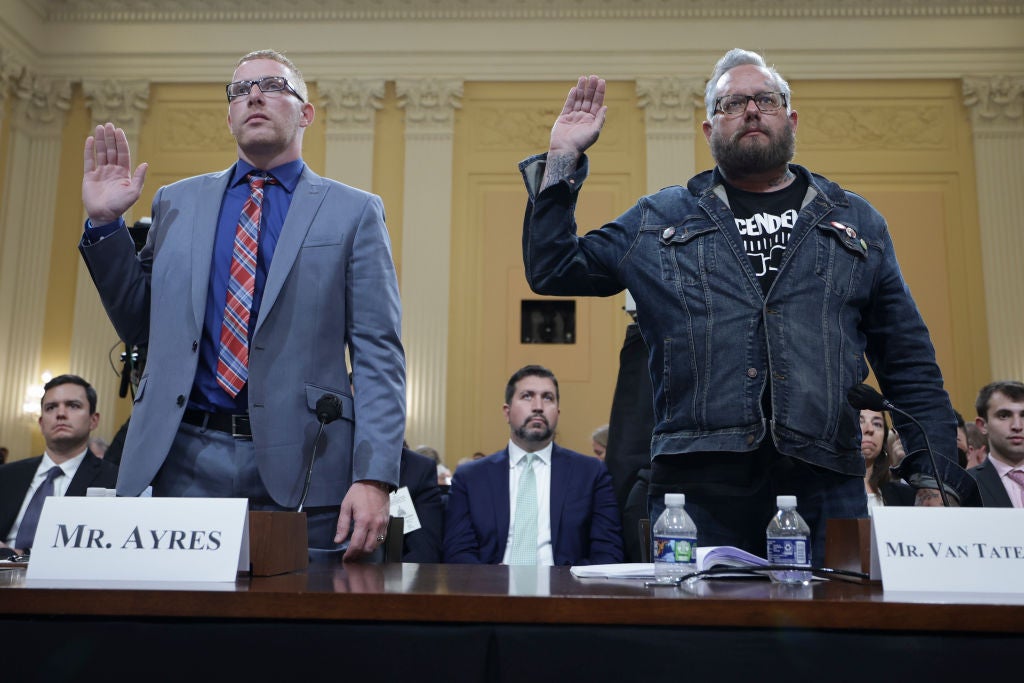‘I’m ready to die for my beliefs’: How Trump supporters were radicalized and tempted to the Capitol
We now know that the march on the Capitol on January 6th wasn’t spontaneous, not by a long shot


Your support helps us to tell the story
From reproductive rights to climate change to Big Tech, The Independent is on the ground when the story is developing. Whether it's investigating the financials of Elon Musk's pro-Trump PAC or producing our latest documentary, 'The A Word', which shines a light on the American women fighting for reproductive rights, we know how important it is to parse out the facts from the messaging.
At such a critical moment in US history, we need reporters on the ground. Your donation allows us to keep sending journalists to speak to both sides of the story.
The Independent is trusted by Americans across the entire political spectrum. And unlike many other quality news outlets, we choose not to lock Americans out of our reporting and analysis with paywalls. We believe quality journalism should be available to everyone, paid for by those who can afford it.
Your support makes all the difference."Is the 6th D-Day? Is that why Trump wants everyone there?"
"Trump just told us all to come armed."
"It ‘will be wild’ means we need volunteers for the firing squad."
"I’m ready to die for my beliefs, are you ready to die police."
This was how extremists reacted on social media to a tweet heard around the right-wing ecosystem.
We now know that Trump’s early morning tweet on December 19, 2020 calling for a protest on January 6 changed the plans of extremist groups and led directly to the violence that day. We now know exactly how pre-planned Trump’s call for his supporters to "march on the Capitol" was. We now know more details about "the craziest meeting" of the Trump administration on the night of December 18 where "Kraken" conspiracy theorist lawyer Sidney Powell almost became Special Counsel. We now know that Trump’s tweet sparked the Oath Keepers, Proud Boys, and 3%ers to coordinate their efforts, with the help of key Trump allies.
Today’s hearing focused on the time period between December 14 and January 6. While previous hearings focused on theeffort to pressure Vice President Mike Pence to overturn the election,demands of state officials to overturn the election, and thepressuring of the DOJ to claim the election was stolen, this hearing focused on another key component of Trump’s insurrection plot: the planning of the violent assault on the Capitol.
The Kraken Coup Meeting
After December 14, all bets were off. Legitimate electors had met and proclaimed Joe Biden president-elect. Trump needed to act fast. Rep. Jamie Raskin (D-MD) laid out the details of an insane December 18 White House meeting with Rudy Giuliani, Sidney Powell, Michael Flynn, and former Overstock CEO Patrick Byrne using Trump officials’ own words.
The meeting became "heated" and "profane" after Trump officials like Pat Cipollone learned of it and interfered. Powell and Flynn presented a draft executive order dated December 16 that would have seized voting machines and named Powell Special Counsel. Powell testified that Trump asked Cipollone if he could appoint her as Special Counsel and grant her a security clearance. Cipollone testified that he didn’t take any steps to do that, but that Powell was still asserting that she had been appointed in the days after.
There was yelling, and even threats of physical fights, as White House lawyers destroyed the legal premises Powell and Flynn presented. Cipollone called the executive order a terrible idea. The meeting moved around the White House and into the private residence at times, lasting well past midnight. Cassidy Hutchinson took a photo of Mark Meadows escorting Rudy Giuliani off White House grounds.
The Tweet Heard As A Directive
It was after this chaotic night that Trump sent the now-infamous directive to his supporters. At 1:42 am, Trump tweeted: "Big protest in D.C. on January 6th. Be there, will be wild!" Immediately after this tweet, there was a flurry of violent chatter among extremist groups and conspiracy theorists. At 10:22 am that very same morning, Florida’s Oath Keepers leader Kelly Meggs posted about an alliance between the Oath Keepers, 3%ers, and Proud Boys. There was now collaboration between multiple extremist groups sparked by Trump’s tweet.
Former Chief of Homeland Security and Intel for DC Donell Harvin testified about how he also saw indications online of white nationalists, anti-government militias, and conspiracy theorists all beginning to collaborate in the days leading up to January 6. It’s now even more apparent that when Trump told the Proud Boys to "stand back and stand by" on September 29, 2020, they were listening loud and clear.
The Committee highlighted another key detail tying Trump directly to the planning of January 6. After his tweet, multiple groups changed the dates of their rallies. The Women For America First PAC had previously applied for a post-inauguration rally permit on a different day, but changed the date to January 6. "Stop The Steal" organizer Ali Alexander created a website promoting a January 6 rally. Right-wing media figures, including Alex Jones, pushed the date, with one commentator calling for a "red wedding," referencing a mass slaughter on the show Game of Thrones.
A Twitter employee testified that they advocated for Trump to be penalized by the company after his "stand back and stand by" comments out of fear he would use the platform to further communicate to extremists. When Trump sent his December 19 tweet, it sparked further deliberations about enhanced moderators. Twitter didn’t act until after January 6. Meanwhile, Trump continued to do exactly what that employee feared.
The March On The Capitol Wasn’t Spontaneous
In the last hearing, which featured Cassidy Hutchinson’s testimony, it was revealed that Trump knew his supporters were armed with guns and body armor and directed them to the Capitol anyway. It was also revealed how Trump intended to join the rioters at the Capitol. Today, the January 6 Committee broke down how the call to march on the Capitol wasn’t a spontaneous remark on Trump’s part, but a pre-planned scheme.
The committee revealed a draft tweet from Trump, in which he was going to explicitly tell followers to march to the Capitol and "stop the steal." On January 4, Women for America First Executive Director Kylie Kremer leaked to MyPillow CEO Mike Lindell that Trump was going to tell supporters to march on the Capitol in his speech on January 6. She cautioned, "It cannot get out about the march because I will be in trouble." Ali Alexander was also aware, according to a January 5 text message. The march on the Capitol was part of the plan, but they knew if it was publicly known that it was pre-meditated, it would be damning.
On January 5, Trump mused in an Oval Office meeting about how to get the "RINOs" to do the right thing. Rep. Stephanie Murphy (D-FL), who co-led today’s hearing with Rep. Raskin, revealed that on January 5, after Trump listened to the violent rhetoric of the Stop The Steal rally outside the White House, he rapidly edited his speech well into January 6. The morning of January 6, he added lines attacking Mike Pence.
The committee revealed encrypted messages from a group chat called "Friends of Stone" that included Roger Stone, Oath Keepers leader Stewart Rhodes, Proud Boys leader Enrique Tarrio, and Ali Alexander. Both Rhodes and Tarrio have since been charged with seditious conspiracy in connection with the planning of the January 6 violence.
Florida Oath Keepers leader Kelly Meggs sent a message on January 5 where she said she discussed security with Roger Stone. Stone was then guarded by Oath Keepers in DC on January 6. The committee played a video of Stone taking the Proud Boys oath — incredibly daming, especially given that Stone was in the Willard Hotel’s "War Room", where Mark Meadows called in on January 5.
The Dangers Of Radicalization
Today’s in-person witnesses were Stephen Ayres, a Capitol rioter who pleaded guilty, and Jason Van Tatenhove, a former spokesperson for the Oath Keepers. Van Tatenhove testified that the Oath Keepers are a "dangerous organization" and highlighted how the radicalization process leads to white nationalism. Ayres said that when he saw Trump’s tweet telling them to leave the Capitol, he and many others immediately left. This highlighted how much control Trump had over the rioters.
Even Trump’s own team understood that power. The January 6 Committee showed former Trump campaign manager Brad Parscale texting former Trump aide Katrina Pierson, saying he felt guilty for helping Trump win and adding that Trump’s rhetoric had gotten “a woman” (likely Ashli Babbit) killed.
Ayres served as the personification of how Trumpism radicalizes Americans. Through his testimony, the January 6 Committee rightfully highlighted that the Big Lie served as a radicalizing mechanism that sent people down a spiral of right-wing extremism. Jason Van Tatenhove warned that if Trump was willing to try and incite a civil war, he wonders what Trump would do if he gets power again.
At the end of this hearing, Rep. Liz Cheney (R-WY) revealed that Trump tried to call a witness who has yet to publicly appear. The witness alerted their lawyer, who told the committee. The committee has alerted the DOJ. This could be more evidence of witness-tampering.
The extremist groups we heard about today were the violent arm of Donald Trump’s coup attempt. These groups have a disdain for democracy, with white supremacist motivations. From his infamous "good people on both sides" Charlottesville remark to his "stand back and stand by" 2020 debate, Trump tapped into the dark underbelly of American life and expertly exploited the hateful and conspiracy theory-driven rot at the center of America’s divisive devolution. These are the remnants of the Confederacy that never died.
Jamie Raskin said it best in today’s hearing: "American carnage, that’s Donald Trump’s true legacy."